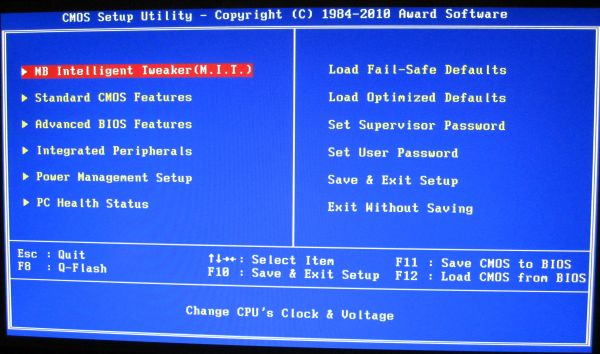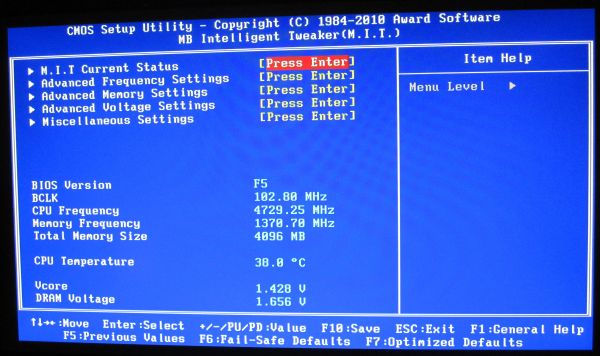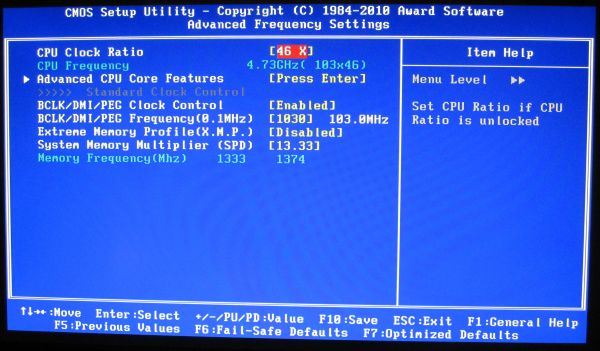The Battle of the P67 Boards - ASUS vs. Gigabyte at $190
by Ian Cutress on January 20, 2011 4:15 PM EST- Posted in
- Motherboards
- Gigabyte
- Asus
- P67
BIOS
Gigabyte has not been on the ball BIOS/UEFI wise for Sandy Bridge. In the Visual Inspection, I explained at how the board is actually 64-bit UEFI but with a BIOS interface attached (for stability, after years of working at it) with plans to possibly upgrade to a GUI at a later date. Though in the name of stability, the launch BIOS has significant issues with turbo boosting, where only a 1x multiplier boost gets applied at any thread loading, rather than 4x/3x/2x. It wasn't as simple as downloading the latest BIOS from the website and updating - in order to get it to work properly, I had to load in an OS, and download the latest version of @BIOS, their BIOS updating tool, and grab the latest BIOS. You cannot use the version of @BIOS on the CD, you need the latest version, and you cannot use QFlash in the BIOS, as they both do not recognise any BIOS F6 or above as valid. I downloaded the latest BIOS file from the website, and use @BIOS to update from the file. At the time of writing, the F7b BIOS is the latest, which implements turbo modes correctly.
If you have worked with a BIOS before, Gigabyte is not throwing up too many new features to surprise you – only those based around Sandy Bridge. Everything overclocking, CPU and voltage related is found in the Intelligent Tweaker menu, whereas boot order can be found in the advanced BIOS options.
The Intelligent Tweaker menu gives a quick overview of BCLK, frequency, temperature, voltages, etc. By dividing the all the OC options into the ‘frequency’, ‘memory’, and ‘voltage’ sub-menus, while this splits up the options to make them easier to digest, it does result in more navigation. Personally, I would prefer being able to adjust the CPU/DRAM voltages in the frequency settings as well as the voltage settings.
Thankfully, most of the settings can be adjusted by typing in a value, or by the +/- buttons, or by pressing enter to type/bring a scrollable menu up. I like being able to do this in a BIOS/UEFI, and most manufacturers will leave out at least one of the available ways to change a setting in every sub-menu, or mix and match as they deem appropriate.
The BIOS allows eight profiles to be saved on board, or you can save/load to a file. Given some of the overclocking problems I mention below, every time a re-flash of the BIOS was required, all my saved on board settings were lost.
Overclocking
Overclocking on the P67-UD4 was almost as easy as it has been on previous BIOS boards, although there was no easy overclock presets available in the BIOS. EasyTune6, the OS software on the Gigabyte CD, gives automatic options for 35x, 37x and 40x multiplier at 100 MHz bus speed. These settings, as in previous Gigabyte iterations and boards, work pretty well, but a 4 GHz overclock on Sandy Bridge is not going to win any awards.
Going into the BIOS, I immediately left everything on auto and upped the multiplier to 45x, for a 4.5 GHz processor speed. This successfully booted into Windows, passed the stability tests, then BSOD on shutdown. On the restart, the board attempted to boot back at stock, which was disappointing.
As with previous overclocking attempts, I jumped in and put the VCore straight at 1.42V, with a 1.9V PLL. Upping the multiplier to 45x to give 4.5 GHz this time was no trouble. 4.6 GHz and 4.7 GHz also passed without issue. 4.8 GHz booted into the OS, but failed the OCCT stress test, so I rolled back the multiplier to 47x and started playing with the BCLK by 1 MHz at a time. 101 MHz also failed the stress test, leaving 47 * 100 MHz as a good overclock. This board automatically puts a -0.2 MHz bias on the BCLK, meaning that the speed is actually 47 * 99.8 MHz = 4.69 GHz.
Out of interest, I rolled back the multiplier again to 46x and upped the BCLK this way. With a 102.2 MHz BCLK, it would beat the speed of the 47 * 100 MHz overclock, so I booted at 102.5 MHz (102.3 MHz effective), with a 46x multiplier, which passed. 103 MHz did not however, so 102.5 MHz * 46 (102.3 MHz * 46 effective = 4706 MHz) would seem the best option, as it contains that small little BCLK boost to help other components and memory.
With the board’s Dual BIOS system, on a severe failed boot type unsuccessful overclock by increasing the multiplier too much, the board would revert to the backup BIOS, and then boot me straight into the BIOS. If I changed anything, it would load the standard BIOS again with my new settings. Also of note, if I upped the BCLK too far, the system would restart in one of two ways – without any overclock at all, or at 100 MHz with my chosen multiplier. If I increased the RAM too far, it would keep rebooting and never getting to the POST screen until I used a jumper on the Clear CMOS header. Note, no jumpers are included in the box, so you have to find your own way of shorting those pins. I also tried going for 50x multiplier, 100 MHz BCLK, at 1.50 V. On a failed boot into Windows, the main BIOS became corrupted and had to be restored by the backup – then I had to load into the OS to run @BIOS to update to the F7b BIOS again, because the backup BIOS is F1 and doesn’t recognise the F7b BIOS file as a valid BIOS, which was frustrating.
At 4.706 GHz (42.6% OC over 3.3 GHz/non turbo/multithreaded, 27% OC over 3.7 GHz/turbo/single-threaded), the 3D Movement benchmark was run. In single thread mode, a score of 145.19 was achieved, a 28% increase. In multi-threaded mode, a score of 463.12 was achieved, a 38.6% increase.



















137 Comments
View All Comments
erple2 - Friday, January 21, 2011 - link
Technically, there has simultaneously always and never been a "perfect storm" of price and performance. Things always get faster at the same price point over time.As a commenter above pointed out, while these machines may be able to decode stuff quickly (and I'm guessing the 2600k will be faster), when their "system price" comes down to whatever sweet spot you are targeting, we'll have additional things we want to do with our computers (3D movies, 4K HD, 8K hD etc) that will tax these beyond what we consider "reasonable" today.
Ultimately, things ALWAYS get cheaper for the same level of performance and/or do more with the same cost. That's what progress "mandates". Unfortunately, we demand more things to be done, so the perceived amount of extra work you can do never really seems to go down. I used to be happy running a 386-DX40 in the DOS days. Things seemed fast and speedy then. I acknowledge that I do more today than I did back then, though I'm not sure if that's because the software does more, rather than I do more.
My advice - pick a budget and when you can no longer reasonably do what you now do, then buy with an eye to the future. I picked a fairly high budget, but I wanted to get a 'significant' upgrade that would still be usable 3 years in the future. My Core2Duo lasted from 2007 until the end of 2010, when I (foolishly) bought an i7-950.
marc1000 - Friday, January 21, 2011 - link
and in the 067 boards we can't use the encoding abilities from Sandy Bridge, because the on-chip GPU is turned-off in this chipset. so the only value in $150 boards is x8/x8 PCIe (cheaper boards cut this to x16/x4, a stupid thing but the only way to force us to spend more).medi01 - Saturday, January 22, 2011 - link
Which "encoding abilities" are we talking about, please? Shamelessly hyped increased speed, achieved at the cost of quality loss, eh?Beenthere - Thursday, January 20, 2011 - link
Asus has a long history of delivering half-baked goods - which this review confirms has happened once again. That and the fact that Asus provides zero customer support in my and many other customer's experience, means I'll vote with my wallet and get the Gigabyte mobo. I know the Asus fanbois will ignore the product defects and buy the Asus mobo anyway because of some review which shows it will OC by 2 Hz. more or something insignificant. This is how Asus dupes the naive kids.Rick83 - Thursday, January 20, 2011 - link
Well, I'm monitoring the Gigabyte boards, and there's the same image as you'd expect from the ASUS side. Plus with the weird BIOS-flash thing happening on all the boards, and the features that are missing on the Gigabyte boards, I think I'll take an ASUS this time around. (Though any board will be a step down from my brilliant IP35 Pro.... RIP ABIT)Digital Audio Inputs seem to have died out completely....
In the end, I think I'll go with the microATX ASUS in the new Fortress FT3 by Silverstone...
SmCaudata - Thursday, January 20, 2011 - link
I want to do the same build. I'm hoping for a new GENE or equivalent ASrock board. The FT3 looks like it can handle SLI well. Would be fun to build that powerful of a system in w small package and still have awesome thermals.Gothmoth - Thursday, January 20, 2011 - link
gigabyte boards make way more trouble then asus boards.don´t remind me on the samsung drives or hitachi drives that would not work for 8 month with gigabyte boards.
take a look at gigabytes support forum and you will see how "happy" the gigabyte users are. LOL.
milkyway4me - Thursday, January 20, 2011 - link
Asus does advance RMA, gigabyte doesn't. That and that alone, is why any reasonable person should choose Asus barring some massive issue that sticks out to them.Duwelon - Thursday, January 20, 2011 - link
And i've had the exact experience with Asus and Gigabyte. Last 3 computers I built all used Gigabyte board. 1 bad video card (fanless gigabyte 4550 and they replaced it with a geforce 9600gt with a fan... gee thanks for the downgrade in performance and features and upgrade in noise, thanks so very much). 1 Gigabyte board is acting up, the NIC keeps disappearing without a trace, had to install a PCI NIC to keep it on the network. I friggin hate Gigabyte's RMA process, but they're still better than some i've had to use. Asus, never had a problem with their RMA and they were a little faster than Gigabyte from what I remember. To each their own, sadly they both have flaws and neither are much better than the other. Overall though, given my recent screwing over by Gigabyte and recent issues, my pendulem is swinging towards Asus again.seamusmc - Friday, January 21, 2011 - link
I've had boards from all major vendors, ASUS, Intel, Gigabyte, Abit, DFI, etc. They've all had duds and they've all had great boards. I currently have 4 ASUS x48 Rampage's, (Home Server, Work, Wife and Game), and it is one of my favorites among many favorites. ASUS CULV is another stand out in my memory.In my experience, ASUS hasn't delivered more half-baked goods then anyone else.
Right now, it seems to me all the boards are having issues and that's to be expected with a new chipset. This is why I decided last month, despite my unquenchable hunger to upgrade, to wait at least until Feb to upgrade. At this point I may wait until March.